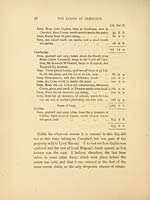Lairds of Glenlyon
(69) Page 57
Download files
Complete book:
Individual page:
Thumbnail gallery: Grid view | List view

THE LAIRDS OF GLENLYON. 57
ing satisfaction. In 1695 an action at civil law was com-
menced against Coll of Keppoch by the Lady Glenlyon in
the absence of her husband, but I believe a long bill of
costs against her was the only result ; for, though a verdict
was easily obtained, " Coll of the Cows," was not the man
to obey implicitly the decree of a judge. Excluding
Gallin from the list, the other farms were held by Campbell
in right of his wife, whose jointure they were, and they
formed the whole of his possessions in Glenlyon. The
foray left the laird and his tenants on the brink of starva-
tion. And that would have been undoubtedly their fate
next year, as, for want of horses, most of the land lay un-
filled, had not the laird's son-in-law, Alexander Campbell
of Ardeonaig, stretched his credit with the Laird of Ochter-
tyre, from whom he procured meal and grain for Campbell
and his dependents. Any one, by running his eye over the
foregoing list, will understand at once the thorough way in
which the Highland robbers swept a glen. Here, at one fell
swoop, a poor landlord and his few dependents lose their
whole stock — all they had in the world — 36 horses, 240 cows,
993 sheep, 133 goats, and whatever was portable of their little
household furniture. The money value was estimated at
£7,540 17s. 1 id. Scots money, which was a large sum
indeed in those days. Campbell, driven in his old age —
he bordered on 60 — to earn his daily bread, resumed his
sword and became a soldier of the Revolution. Early in the
year 1690, he obtained a company in the Earl of Argyle's
Regiment of Foot.
ing satisfaction. In 1695 an action at civil law was com-
menced against Coll of Keppoch by the Lady Glenlyon in
the absence of her husband, but I believe a long bill of
costs against her was the only result ; for, though a verdict
was easily obtained, " Coll of the Cows," was not the man
to obey implicitly the decree of a judge. Excluding
Gallin from the list, the other farms were held by Campbell
in right of his wife, whose jointure they were, and they
formed the whole of his possessions in Glenlyon. The
foray left the laird and his tenants on the brink of starva-
tion. And that would have been undoubtedly their fate
next year, as, for want of horses, most of the land lay un-
filled, had not the laird's son-in-law, Alexander Campbell
of Ardeonaig, stretched his credit with the Laird of Ochter-
tyre, from whom he procured meal and grain for Campbell
and his dependents. Any one, by running his eye over the
foregoing list, will understand at once the thorough way in
which the Highland robbers swept a glen. Here, at one fell
swoop, a poor landlord and his few dependents lose their
whole stock — all they had in the world — 36 horses, 240 cows,
993 sheep, 133 goats, and whatever was portable of their little
household furniture. The money value was estimated at
£7,540 17s. 1 id. Scots money, which was a large sum
indeed in those days. Campbell, driven in his old age —
he bordered on 60 — to earn his daily bread, resumed his
sword and became a soldier of the Revolution. Early in the
year 1690, he obtained a company in the Earl of Argyle's
Regiment of Foot.
Set display mode to:
![]() Universal Viewer |
Universal Viewer | ![]() Mirador |
Large image | Transcription
Mirador |
Large image | Transcription
Images and transcriptions on this page, including medium image downloads, may be used under the Creative Commons Attribution 4.0 International Licence unless otherwise stated. ![]()
| Histories of Scottish families > Lairds of Glenlyon > (69) Page 57 |
|---|
| Permanent URL | https://digital.nls.uk/95355727 |
|---|
| Description | A selection of almost 400 printed items relating to the history of Scottish families, mostly dating from the 19th and early 20th centuries. Includes memoirs, genealogies and clan histories, with a few produced by emigrant families. The earliest family history goes back to AD 916. |
|---|

